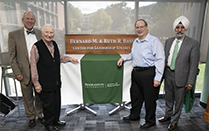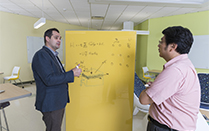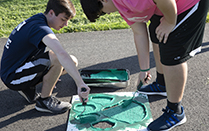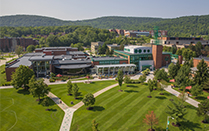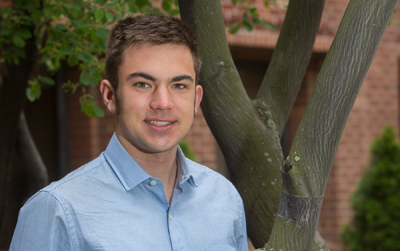
Goldwater scholar focuses on wind energy
A year ago, Brandon Pereyra perched 165 feet above the plains of Golden, Colo., looked to the distant Rocky Mountains, then returned his attention to the gears of a wind turbine and how to make them more effective.
Now the winner of one of America’s most prestigious scholarships, Pereyra plans to spend the summer at the turbine’s base trying to model how waves, currents and water interfere with how wind is turned into energy.
Winning the Barry M. Goldwater scholarship, a $7,500 prize given to 260 undergraduate researchers, is nice, but just a mile marker on the road to something really big: efficient, affordable, green energy.
“We’re hoping to put wind turbines offshore,” said the 20-year-old Binghamton University undergraduate. “The big complication is that rather than a fixed base, it has multiple degrees of freedom.”
Turbine platforms face waves, current, storms and, naturally, the wind. All that can affect the power collected. And as farms crop up, the turbines themselves affect the wind flow to neighboring turbines.
Pereyra won the scholarship — a federal program that honors the late U.S. senator and fosters math, engineering and science advances — based on his academic record and a proposal to research and develop the computational modeling to make turbines more effective.
“I’ve really been pretty passionate about renewable energy since I got here,” said Pereyra, from Westhampton Beach, on Long Island. “I thought about where the problems lie for our society. We’re entirely run off fossil fuels. Why spend resources developing a technology our children are going to struggle to live without?”
His challenge is that much of the existing modeling for wind turbines comes from the offshore oil industry. But the two platforms are very different. Oil rigs are huge and can ignore some forces, higher order wave effects, for example, that would tear a turbine platform apart. Likewise, an oil rig’s size means it must deal with other forces small platforms overcome easily.
Pereyra began learning how to do that during a 2014 internship with the National Renewable Energy Laboratory in Golden, Colo., studying how wind farms are affected, and affect, wind. He’ll continue that work this summer, again with the NREL, dealing with offshore platforms.
“We have to see how that applies to our technology. Sometimes it does; sometimes it doesn’t,” he said. The new models he hopes to develop would be both faster and more accurate.
Pereyra’s first steps in fluid dynamics and modeling came in the lab of Bruce Murray, a professor of mechanical engineering at Binghamton. While there, Pereyra exhibited one of the most crucial traits of a good researcher, Murray said: curiosity.
“He struggled, but he asked lots of questions and figured things out,” Murray said. “Some kids are really just sharp and motivated. And it’s very rare that students that new get into modeling to that extent.”


